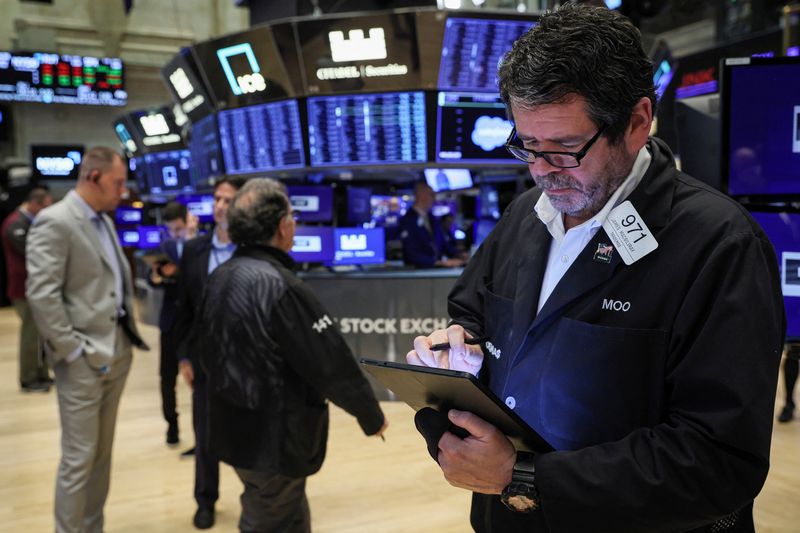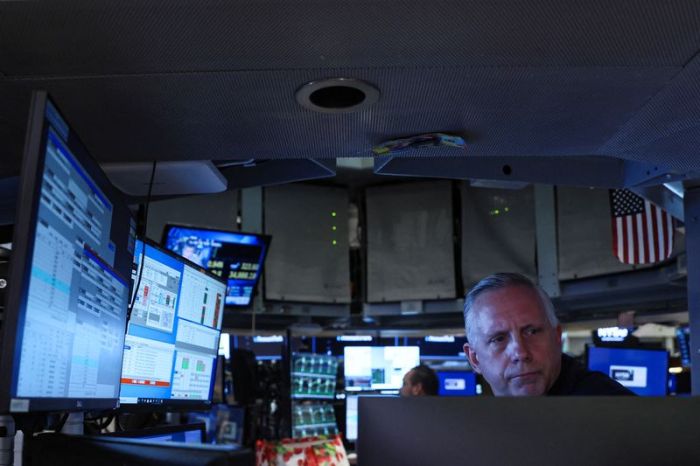NEW YORK (Reuters) – Wall Street ended a volatile trading day higher on Monday and benchmark U.S. Treasury yields breached the 3% mark as investors braced for a widely anticipated U.S. Federal Reserve interest rate hike.
All three major U.S. stock indexes gyrated between positive and negative territory throughout the session, and the 10-year Treasury yield touched its highest level in more than three years.
Wall Street’s last-minute rally came on the heels of the S&P 500’s worst January-April percentage drop since 1932, as market participants steadied themselves for any signs of increased hawkishness from the Fed at the conclusion of its monetary policy meeting on Wednesday.
“The market is faced with a number of challenges and there’s not a lot of conviction one way or the other,” said Robert Pavlik, senior portfolio manager at Dakota Wealth in Fairfield, Connecticut.
“It’s becoming very reminiscent of the early ’70s,” Pavlik added. “We’ve hit 3% on the 10-year (Treasury yield), interest rates are going up, there’s a war going on, the economy is slowing down. All we need is Richard Nixon to come out of the ground.”
A report from the Institute for Supply Management showed U.S. factory activity losing steam, its purchasing managers’ index (PMI) coming in well below consensus.
This followed a PMI report from China showing factory activity contracting for the second straight month as widespread COVID-19 shutdowns disrupted production and supply chains.
The Dow Jones Industrial Average rose 84.29 points, or 0.26%, to 33,061.5, the S&P 500 gained 23.45 points, or 0.57%, to 4,155.38 and the Nasdaq Composite added 201.38 points, or 1.63%, to 12,536.02.
At its low point for the day, the S&P 500 was down as much as 1.7%.
The glum China factory data dragged European stocks to a sharply lower close, although the STOXX 600 pared its losses following a sudden 3% plunge earlier in the session – what some brokers called a “flash crash” caused by an erroneous trade.
The pan-European STOXX 600 index lost 1.46% and MSCI’s gauge of stocks across the globe shed 0.05%.
Emerging market stocks lost 0.47%. MSCI’s broadest index of Asia-Pacific shares outside Japan closed 0.47% lower, while Japan’s Nikkei lost 0.11%.
Long-dated U.S. Treasury yields hit multi-year highs, with the benchmark 10-year yield crossing the 3% barrier for the first time since December 2018.
Benchmark 10-year notes last fell 26/32 in price to yield 2.9866%, from 2.885% late on Friday.
The 30-year bond last fell 58/32 in price to yield 3.0487%, from 2.946% late on Friday.
Crude prices turned around mid-session, as worries over weak demand due to bleak factory data from China were overshadowed by a potential European ban on Russian oil that stoked fears of tightening supply. [O/R]
U.S. crude settled at %105.17 per barrel for a 0.46% gain on the day, while Brent gained 0.41% to settle at $107.58 per barrel.
The dollar hovered around a 20-year high against a basket of currencies ahead of the Fed’s expected rate hike as investors focused on the possibility that the FOMC could adopt an even more hawkish stance than expected.
The dollar index rose 0.65%, with the euro down 0.36% to $1.0503.
The Japanese yen weakened 0.27% to 130.20 per dollar, while Sterling was last trading at $1.2488, down 0.66% on the day.
Gold prices plunged to near 3-month lows as the prospect of faster-than-anticipated interest rate hikes from the Fed lifted Treasury yields and the greenback.
Spot gold dropped 1.8% to $1,862.22 an ounce.
(Reporting by Stephen Culp; Additional reporting by Danilo Masoni; Editing by Will Dunham)

























